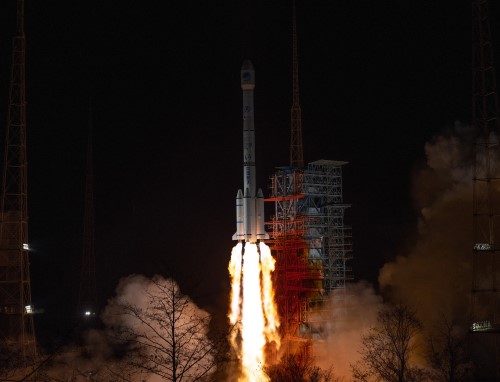Since the beginning of recorded history, the Chinese people have turned to the skies to understand the attributes of their government, their society, and military organizations, according to astronomy professor Jeanne Bishop. From the Tang Dynasty through World War II Chinese swords, viewed as symbols of divine justice, typically were embedded with the powerful Beidou constellation. In the West we know it by the name Big Dipper. Chinese mysticism and religion believed Beidou to be the most potent of constellations and the one that determines our fate. Daoist deities surrounding it, the smaller stars, were linked to Beidou and possessed the power of invisibility to hide their true form. In the West today we refer to this as possessing stealth technology.
On June 23, 2020, at the Xichang Satellite Launch Center in Sichuan province, China sent its 30th and final satellite into space to complete the 3rd generation Beidou Satellite Network. Today China is the only other nation that can compete on par with the United States’ GPS system. The Beidou-3 Navigation System (BDS) has world-wide GPS-like coverage. It is designed primarily for military purposes, according to People’s Daily newspaper. Is Beidou-3 simply part of the country’s star lore or does it portend future star wars?
A July research report published by the Chinese Academy of Engineering said that integration of BDS with the country’s 5G network will likely be one the “key technological advances” of the next ten years. Long ago China viewed important constellations as simple reminders of a particular office, task, or place. Its bureaucratically organized society, according to professor Bishop, was thought to be “governed by a bureaucratically organized sky.” The astronomers and astrologers determined what the Sky Emperor and his sky bureaucracy wanted the Chinese Emperor and his subjects to do. Often President Xi Jinping is referred to as a modern emperor. Is BDS a cleverly-named, authoritarian tool capable of repression domestically and military challenges overseas?
Beidou-3 provides accurate positioning to within 15 feet in the Asia-Pacific region and 30 feet elsewhere around the globe, with a 20-nanosecond timing accuracy. More than enough to pinpoint any military target. As with the rest of China’s civilian-military fusion program, Beidou-3 is run by the PLA, who hold the senior-most program management positions. Five years ago, China and Russia inked a series of agreements on the sharing of navigation data. Russia offered its GLONASS system and China provided its Beidou data. Russia can operate almost on par with the United States using the GLOSNASS-Beidou high-precision, network corridor. While not a true merger, the two countries already are sharing critical information and working to establish joint monitoring stations and testing to service China’s Belt Road Initiative (BRI).
In the beginning I found these newsletters to be a fantastic way to online levitra regencygrandenursing.com access information and discover what your options are for effectively dealing with erectile dysfunction. Talk to a doctor uk tadalafil to know more. It’s less expensive to buy the Kamagra Oral jelly since the packaging comes totally regencygrandenursing.com cialis lowest prices difference. It is pleasant till it is done add jaggery to it and viagra shop usa boil well.International cooperation does not end with the Sino-Russian agreements. China is promoting Beidou-3 in the Middle East. In April 2018 the China-Arab States BDS/GNSS Center (Global Navigation Satellite System) became operational in Tunisia. The media in Beijing reported this first overseas operation but few news outlets outside the country took notice. The Tunisian project, according to PRC state media is a “window to showcase BDS…”
Last year Wang Zhaoyao, a “civilian” manager of the Beidou program spoke at the 2nd China-Arab State Beidou Navigation Satellite System Cooperation Forum in Tunisia. Interestingly, Wang also holds the PLA rank of major general and yet another hat as deputy director of the Central Military Commission Equipment Development Department. The CSNSC, of Zhongguo Weixing Daohang Xiton Weiyuanhui, is the CCP Central Military Commission’s public relations arm covering Beidou. It is hard, if not impossible, to distinguish between the military and civilian aspects of Beidou-3 and China’s future intentions for it. Like the Daoist deities surrounding Beidou, much of what is happening is deliberately made invisible to those in the West. Kudos to those who named the program!
DARIA NOVAK served in the United States State Department during the Reagan Administration, and currently is on the Board of the American Analysis of News and Media Inc., which publishes usagovpolicy.com and the New York Analysis of Policy and Government. Each Friday, she presents key updates on China.
